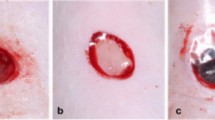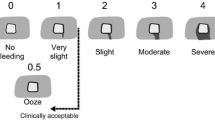Abstract
We investigated the inflammatory response in pigs exposed to salmon fibrinogen/thrombin dressings. Animals were exposed to the material in 3 ways: (a) thrombin and fibrinogen were injected intravenously, (b) dual full-thickness skin lesions were surgically created on the dorsal aspect of the swine and treated with the fibrinogen/thrombin bandage and a commercial bandage or (c) a fibrinogen/thrombin bandage was inserted through an abdominal incision into the peritoneal cavity. Blood was collected twice weekly and animals were sacrificed at 7, 10 or 28 days. Animals in the 28-day dermal lesion group were given an injection of salmon fibrinogen/thrombin at the 10 day point to simulate a second bandage application. The immune response manifested itself as induction of germinal centers in mesenteric lymph nodes and in the white pulp of the spleen. Examination of the histology of the skin and organs showed a cellular inflammatory response with granulation tissue and signs of edema that resolved by the 28-day stage. Antibodies reactive to salmon and human thrombin and fibrinogen were detected, but fibrinogen levels and coagulation processes were not affected. In conclusion, animals treated with salmon fibrinogen/thrombin bandages demonstrated a smooth recovery course in terms of both tissue healing and the immune response without adverse effects from the exposure to the fish proteins.






Similar content being viewed by others
Abbreviations
- TNF:
-
Tissue necrosis factor
- PDS:
-
Polydioxanone suture
- H&E:
-
Hematoxylin and eosin
References
Champion HR, Bellamy RF, Roberts CP, Leppaniemi A. A profile of combat injury. J Trauma. 2003;54(5 Suppl):S13–9.
Holcomb JB, McMullin NR, Pearse L, Caruso J, Wade CE, Oetjen-Gerdes L, et al. Causes of death in U.S. Special Operations Forces in the global war on terrorism: 2001–2004. Ann Surg. 2007;245(6):986–91.
Jackson MR, Taher MM, Burge JR, Krishnamurti C, Reid TJ, Alving BM. Hemostatic efficacy of a fibrin sealant dressing in an animal model of kidney injury. J Trauma. 1998;45(4):662–5.
Pusateri AE, Modrow HE, Harris RA, Holcomb JB, Hess JR, Mosebar RH, et al. Advanced hemostatic dressing development program: animal model selection criteria and results of a study of nine hemostatic dressings in a model of severe large venous hemorrhage and hepatic injury in Swine. J Trauma. 2003;55(3):518–26.
Aguzzi A, Glatzel M. Prion infections, blood and transfusions. Nat Clin Pract. 2006;2(6):321–9.
Aguzzi A, Heikenwalder M. Pathogenesis of prion diseases: current status and future outlook. Nat Rev. 2006;4(10):765–75.
Rothwell SW, Reid TJ, Dorsey J, Flournoy WS, Bodo M, Janmey PA, et al. A salmon thrombin-fibrin bandage controls arterial bleeding in a swine aortotomy model. J Trauma. 2005;59(1):143–9.
Tarantino MD, Ross MP, Daniels TM, Nichols WL. Modulation of an acquired coagulation factor V inhibitor with intravenous immune globulin. J Pediatr Hematol Oncol. 1997;19(3):226–31.
Lawson JH. The clinical use and immunologic impact of thrombin in surgery. Semin Thromb Hemost. 2006;32 Suppl 1:98–110.
Lawson JH, Lynn KA, Vanmatre RM, Domzalski T, Klemp KF, Ortel TL, et al. Antihuman factor V antibodies after use of relatively pure bovine thrombin. Ann Thorac Surg. 2005;79(3):1037–8.
Wai Y, Tsui V, Peng Z, Richardson R, Oreopoulos D, Tarlo SM. Anaphylaxis from topical bovine thrombin (Thrombostat) during haemodialysis and evaluation of sensitization among a dialysis population. Clin Exp Allergy. 2003;33(12):1730–4.
Orta M, Ordoqui E, Aranzabal A, Fernandez C, Bartolome B, Sanz ML. Anaphylactic reaction after artificial insemination. Ann Allergy Asthma Immunol. 2003;90(4):446–51.
Wang LZ, Gorlin J, Michaud SE, Janmey PA, Goddeau RP, Kuuse R, et al. Purification of salmon clotting factors and their use as tissue sealants. Thromb Res. 2000;100(6):537–48.
Mosher DF, Blout ER. Heterogeneity of bovine fibrinogen and fibrin. J Biol Chem. 1973;248(19):6896–903.
Michaud SE, Wang LZ, Korde N, Bucki R, Randhawa PK, Pastore JJ, et al. Purification of salmon thrombin and its potential as an alternative to mammalian thrombins in fibrin sealants. Thromb Res. 2002;107(5):245–54.
Knebel P, Frohlich B, Knaebel HP, Kienle P, Luntz S, Buchler MW, et al. Comparison of Venae Sectio vs. modified Seldinger Technique for totally implantable access ports; Portas-trial [ISRCTN:52368201]. Trials. 2006;7:20.
Kumar V, Abbas AK, Fausto N, editors. Robbins and Cotran pathologic basis of disease. Philadelphia: Elsevier Saunders; 2005.
Bochsler PN, Slauson DO. Inflammation and repair. In: Slauson DO, Cooper BJ, editors. Mechanisms of disease: a textbook of comparative general pathology. Philadelphia: Mosby, Inc.; 2002. p. 230–40.
Oberyszyn TM. Inflammation and wound healing. Front Biosci. 2007;12:2993–9.
Raja, Sivamani K, Garcia MS, Isseroff RR. Wound re-epithelialization: modulating kerationcyte migration in wound healing. Front Biosci. 2007;12:2849–68.
Strecker-McGraw MK, Jones TR, Baer DG. Soft tissue wounds and principles of healing. Emerg Med Clin North Am. 2007;25(1):1–22.
Rodeghiero F, Castaman G, Dini E. Epidemiological investigation of the prevalence of von Willebrand’s disease. Blood. 1987;69(2):454–9.
Shelat SG, Smith P, Ai J, Zheng XL. Inhibitory autoantibodies against ADAMTS-13 in patients with thrombotic thrombocytopenic purpura bind ADAMTS-13 protease and may accelerate its clearance in vivo. J Thromb Haemost. 2006;4(8):1707–17.
Franchini M. Rituximab in the treatment of adult acquired hemophilia A: a systematic review. Crit Rev Oncol Hematol. 2007;63(1):47–52.
Ahmad A, Aggarwal A, Sharma D, Dave HP, Kinsella V, Rick ME, et al. Rituximab for treatment of refractory/relapsing thrombotic thrombocytopenic purpura (TTP). Am J Hematol. 2004;77(2):171–6.
Oliveira B, Arkfeld DG, Weitz IC, Shinada S, Ehresmann G. Successful rituximab therapy of acquired factor VIII inhibitor in a patient with rheumatoid arthritis. J Clin Rheumatol. 2007;13(2):89–91.
Acknowledgements
The authors are grateful to the staff of the Surgery Department, Division of Veterinary Medicine, Walter Reed Army Institute of Medicine for their expert care of the animals in all phases of the experiments. This research project was supported by funding from the Office of Naval Research, Arlington, VA (Project No.: N0001406MP20010), The Uniformed Services University of the Health Sciences, Bethesda, MD (R070TF) and by the US Army, Military Research and Materiel Command, Ft. Detrick, MD.
Author information
Authors and Affiliations
Corresponding author
Additional information
The opinions or assertions contained herein are the private views of the authors and are not to be construed as official or reflecting the views of the Department of the Army or the Department of Defense.
Rights and permissions
About this article
Cite this article
Rothwell, S.W., Sawyer, E., Dorsey, J. et al. Wound healing and the immune response in swine treated with a hemostatic bandage composed of salmon thrombin and fibrinogen. J Mater Sci: Mater Med 20, 2155–2166 (2009). https://doi.org/10.1007/s10856-009-3769-2
Received:
Accepted:
Published:
Issue Date:
DOI: https://doi.org/10.1007/s10856-009-3769-2




